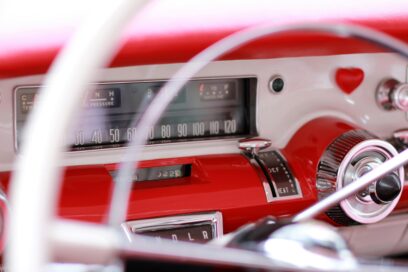You have no items in your cart. Want to get some nice things?
Go shopping
Every Cuban guidebook has a gas guzzling American 1950s classic car on its cover. It is a symbol of Cuba.
These 60 to 70-year-old American classic cars, defying the passage of time, symbolize so much else as well.
That they have survived and are here at all symbolizes a time when Cuba and the United States were friends. That they are in their dilapidated state today symbolizes the end of that friendship.
They symbolize the end of Fulgencio Batista’s cruel tyranny and the beginning of the harsh leadership of Fidel Castro.
They symbolize the resilience and innovation of the Cuban people. The United States’ trade embargo preventing the export of spare parts to Cuba, the owners of these gas guzzlers have somehow managed to keep their cars running and on the road.
Centro – Central Havana boasts the largest concentration of these American gas guzzlers.
Scores of them are parked outside the Gran Teatro de La Habana – The Grand Theatre of Havana, and the Hotel Inglaterra. All convertibles. All restored. All brightly colored blues, reds, greens, and even pinks. Their lines and curves are striking. Their shiny chrome glints in the bright sunshine. These are tourist taxis. Their owners buff them and polish their chrome, waiting for a hirer to come along.
Parked outside El Capitolio – the Capital Building, are scores more. Their paintwork is dull. Their chrome does not sparkle. These are the unrestored cars used by Cubans. Some are colectivos – share taxis.
The models have familiar names: Buicks, Cadillacs, Chevrolets, Chryslers, Dodges, and Fords.
Some models like Packards and Plymouths are near-extinct.
These American relics on wheels evoke a romanticism of yesteryear.
I was photographing a bright fire engine red convertible Chevrolet. The sun shone down brightly on its polished panels, reflecting its high sheen. The bodywork was flawless. Made to be admired from every angle, I took a picture from every angle. Its fins were stunning. Whoever thought to put fins on a car? I wondered.
“You like my car,” a voice behind me asked.
“It’s a beautiful car,” I replied. “You look after it so well.”
“Thank you. Would you like to come for a ride in it?” The man asked.
This was a tourist taxi, amongst the best restored and most attractive of the American gas guzzlers. For a steep tourist price you can be driven around Havana in a classic 1950s convertible for a half-hour. The driver will tell you about his car, and the sights along the way.
“You work so hard on your car. You should relax. I will drive your car. You can sit in the front, or stretch out in the back, relaxed. Which do you prefer?”
He laughed. Perhaps my suggestion was not as original as I thought.
“You are the visitor, señor” he smiled. “It is my responsibility to help you experience my city. You must be the one relaxed. I will do the work.”
“How long have you had this beautiful car,” I asked.
“This car belonged to my uncle. My grandfather bought it new, in 1957. He gave it to my uncle. My uncle gave it to me 5 years ago when he died.”
“Did you restore it?” I wondered.
“Oh yes. For my uncle this car was practical. When it needed a new coat of paint, he painted it with a brush. The brushstrokes were ugly. I sanded the panels back to remove all the paint. Back to the bare metal. My friend is a spray-painter. He made a few repairs to the panels and spray-painted this new finish. A friend of his repaired the dashboard. Parts of the dashboard are new. This new white leather upholstery was made by a leatherworker here in Havana.”
“How is it possible to keep a car like this repaired for so many years,” I asked.
“It is very difficult. The American bloqueo stops the export of spare parts to Cuba,” he said.
The bloqueo – blockade is how Cubans refer to the American embargo.
“So, how are these cars kept running?”
“First, we use the parts of cars no longer on the road. If that is not possible, very clever mechanics will improvise. They will find a different solution. Or they will make the part themselves. If an engine has many problems, the whole engine is replaced. A long time ago they were replaced with diesel engines from Czechoslovakia. Now they are replaced with Japanese engines. It is much easier to obtain parts for Japanese engines.”
These American time machines are not admired for their authenticity. Under the hood of most there is not much of that left. Mostly they are admired for their attractiveness. They are also admired for the Frankensteinian passion and determined inventiveness of their owners and mechanics.
“Many of these cars have Japanese engines?” I repeated, unsure if that is what he had said.
“About one-half of our American cars have Japanese engines. My car still has its original engine,” he said as he went over to the hood and lifted it.
Sections of the engine looked elderly. Other sections looked very new – polished chrome in fact.
“Almost all the engine is original or has original parts from other cars. A few sections are new parts. My cousin in New York gets spare parts in America, some new, some used, and he brings them to me when he visits.”
“Stunning. Absolutely stunning. OK, let’s go for a ride,” I said as I walked to the driver’s side of the car, holding out my hand for the keys.
“You can get in on this side if you would like, but you must sit on the other side,” he laughed.
I laughed as I opened the driver’s side door and sat in the driver’s seat. “This is a big car,” I said, as I slid over to the passenger seat.
“My name is Philip,” I introduced myself.
“Tomás,” he said as he turned the ignition.
The engine did not purr. It throbbed and growled. A quietly purring Japanese engine would have emasculated this car.
We drove along the Malecon. The air was sweet and salty. Handsome fifties finned relics sped along in both directions.
“The restored cars are almost always tourist taxis, like this car,” Tomás explained.
“Would you like to pay a visit to my mechanic,” Tomás asked. “He lives in Vedado. His workshop is at his house.”
“Sure, let’s do that,” I replied.
We arrived at an apartment block in a residential street in Vedado. Opposite was a sprawling three level decaying mansion. Next to it was another, equally crying out desperately for restoration. They had known better days. The apartment block, once modern and attractive, was plain. A driveway sloped down under the apartment building. Tomás walked down the driveway and waved at me to follow.
“Tony,” he called. “Are you here?”
We turned towards the metallic sound of tools clanging on the concrete floor. Tony emerged from under a Buick.
“Hola Tomás,” Tony replied. “Good to see you.”
“Come, let me introduce you to my friend Philip. Philip, this is Antonio. We call him Tony. In Cuba we have very good mechanics. Tony is the best.”
“I’m pleased to meet you, Tony.” Mechanics don’t shake hands when they’re working. Judging by the grime on Tony’s hands, he had been hard at work.
“Welcome to my little shop,” Tony said.
The “little shop” was the huge basement of the apartment building. The not unpleasant smell of oil and gasoline permeated. Five giant American gas-guzzling cars were in varying stages of disassembly, and there was still plenty of room. Shelving lined two walls. They were full of car parts. Some large. Some tiny in small drawers. What looked like a whole engine was in a corner. Next to it rested what looked like a regularly cannibalized engine.
A sedan with its roof removed was transformed into a convertible. Tourists preferred to ride in a convertible so they could soak in the Havana sights from all angles.
“Tony is an improviser,” Tomás explained. “If he does not have a part, and cannot get one, he improvises. My carburetor is not a Chevrolet carburetor. It came from a Russian tractor. Tony made it fit. It has worked now for almost five years. It will probably work forever.
“We have to improvise,” Tony explained “It is best to get the proper part. But so often we cannot get the proper part. Then we must improvise.”
“Ofelia, we have guests,” Tony called out through a doorway. “Can you make three expressos please?”
“How do you get parts like brake pads, or gaskets and seals?” I asked.
“I make them when I need them,” Tony said.
“There must be hard to get parts, like a piston,” I said
“If I don’t have the right one, and I can’t get one, I’ll used whatever piston I do have or can get and I will machine it and grind it until it fits perfectly,” Tony said modestly.
Ofelia came down to the garage and left a tray.
“Gracias Ofelia,” Tony called. “Ofelia is my youngest daughter. She makes the best expresso.”
On the tray were three small expressos, three small glasses of water, and three shot glasses of ron – rum – what else?
The belching roar of another gas guzzler came from the street as it approached. It stopped in front of the driveway. All we could see were its tyres, their rim a striking white.
“Ofelia, we have another guest. Can you make one more expresso please?” Tony called out.
A large man walked down the driveway.
“Hola, Tony,” he called.
“Hola, Augustin,” Tony responded. Introductions followed.
Ofelia returned with another tray with another shot glass of rum, another expresso, and another water.
“Gracias, querida,” – thank you darling, said Tony.
“I have brought you an exhaust system for that Buick over there,” Augustin said. “My brother sourced one in Indiana. It was new about 5 years ago, so it is not very old.”
“That’s great. Thank you, Augustin,” Tony replied.
“And, look at this,” Augustin said, pulling out a half-liter bottle out of his pocket. “This is brake fluid,” he announced proudly.
Tony’s and Tomás’ reaction told me that brake fluid was a precious commodity.
“Now I can stop using shampoo and can use real brake fluid,” Augustin said. “It is just as well, as I was running out of shampoo.”
For these Cubans, their American gas-guzzling cars were an obsession. They loved them, and they would do anything to keep them on the road.
We sipped rum, sipped expresso, sipped water, and reflected on the survival of 1950s American classic cars.
By Philip Mendes





